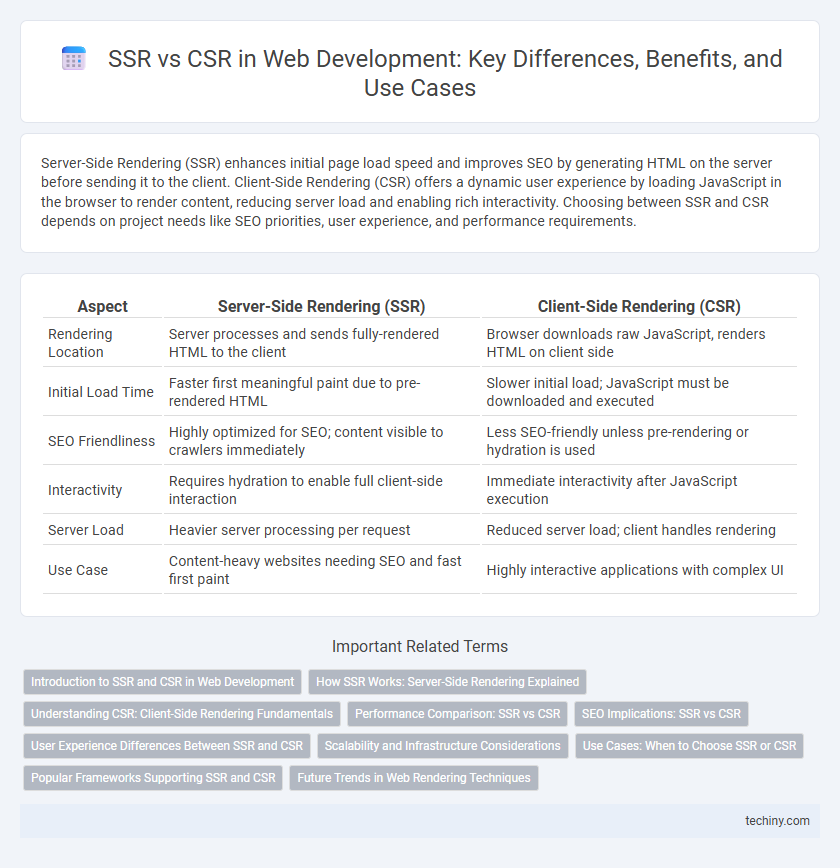Server-Side Rendering (SSR) enhances initial page load speed and improves SEO by generating HTML on the server before sending it to the client. Client-Side Rendering (CSR) offers a dynamic user experience by loading JavaScript in the browser to render content, reducing server load and enabling rich interactivity. Choosing between SSR and CSR depends on project needs like SEO priorities, user experience, and performance requirements.
Table of Comparison
| Aspect | Server-Side Rendering (SSR) | Client-Side Rendering (CSR) |
|---|---|---|
| Rendering Location | Server processes and sends fully-rendered HTML to the client | Browser downloads raw JavaScript, renders HTML on client side |
| Initial Load Time | Faster first meaningful paint due to pre-rendered HTML | Slower initial load; JavaScript must be downloaded and executed |
| SEO Friendliness | Highly optimized for SEO; content visible to crawlers immediately | Less SEO-friendly unless pre-rendering or hydration is used |
| Interactivity | Requires hydration to enable full client-side interaction | Immediate interactivity after JavaScript execution |
| Server Load | Heavier server processing per request | Reduced server load; client handles rendering |
| Use Case | Content-heavy websites needing SEO and fast first paint | Highly interactive applications with complex UI |
Introduction to SSR and CSR in Web Development
Server-Side Rendering (SSR) generates HTML content on the server and sends fully rendered pages to the client, improving initial load speed and SEO performance. Client-Side Rendering (CSR) relies on JavaScript execution in the browser to dynamically render content, enhancing interactivity and reducing server load. Choosing between SSR and CSR depends on factors such as application complexity, user experience requirements, and search engine optimization needs.
How SSR Works: Server-Side Rendering Explained
Server-Side Rendering (SSR) works by generating the full HTML content on the server in response to a user's request, then sending the pre-rendered page to the client's browser. This process enables faster initial page loads and improved SEO performance since search engines can easily crawl the fully rendered HTML. SSR frameworks like Next.js and Nuxt.js optimize web applications by combining server-generated HTML with client-side hydration for dynamic interactions.
Understanding CSR: Client-Side Rendering Fundamentals
Client-Side Rendering (CSR) relies on the browser to generate and display web content dynamically using JavaScript, improving user interactivity and reducing server load. CSR frameworks like React, Vue, and Angular fetch data and render HTML on the client, enabling seamless single-page applications (SPAs) with faster subsequent page transitions. However, CSR may impact initial load times and SEO compared to Server-Side Rendering (SSR) since the content is rendered after the initial page load.
Performance Comparison: SSR vs CSR
Server-Side Rendering (SSR) typically delivers faster initial page loads by generating fully rendered HTML on the server, improving Time to First Byte (TTFB) and enhancing SEO performance. Client-Side Rendering (CSR) relies on downloading JavaScript to render content in the browser, which can increase Time to Interactive (TTI) and cause slower perceived performance on initial load. For dynamic single-page applications with frequent user interactions, CSR can offer smoother runtime performance after the initial load compared to SSR.
SEO Implications: SSR vs CSR
Server-Side Rendering (SSR) significantly improves SEO by delivering fully rendered HTML to search engine crawlers, enabling better indexing and faster content visibility. Client-Side Rendering (CSR) relies on JavaScript to build page content in the browser, often causing delays in content availability to crawlers and potentially lower search rankings. Websites using SSR benefit from enhanced crawlability, faster initial page load times, and improved metadata support, which are critical for search engine optimization performance.
User Experience Differences Between SSR and CSR
Server-Side Rendering (SSR) delivers fully rendered HTML from the server, resulting in faster initial page loads and improved SEO, enhancing user experience with quick content display. Client-Side Rendering (CSR) relies on JavaScript to render content in the browser, leading to slower initial load times but enabling dynamic, interactive user interfaces after loading. Users benefit from SSR's immediate content availability, while CSR offers richer client-side interactions once the application is fully loaded.
Scalability and Infrastructure Considerations
Server-Side Rendering (SSR) enhances initial load performance by rendering HTML on the server, reducing client workload but increasing server resource demands, which can impact scalability if not managed with efficient caching and load balancing strategies. Client-Side Rendering (CSR) offloads rendering to the browser, lowering server strain and offering smoother user interactions at scale, but it requires robust client devices and optimized code to handle performance in high-traffic scenarios. Infrastructure for SSR must prioritize powerful servers and scalable backends, whereas CSR relies more on content delivery networks (CDNs) and distributed client resources for efficient scaling.
Use Cases: When to Choose SSR or CSR
Server-Side Rendering (SSR) is ideal for content-driven websites, SEO-critical applications, and fast initial page loads, as it generates HTML on the server and delivers fully rendered pages to the client. Client-Side Rendering (CSR) suits highly interactive web applications, such as single-page applications (SPAs), where dynamic user experiences and frequent content updates are prioritized after the initial load. Choosing between SSR and CSR depends on factors like SEO requirements, time to first meaningful paint, interactivity level, and server resource availability.
Popular Frameworks Supporting SSR and CSR
Next.js and Nuxt.js are popular frameworks supporting SSR, enabling faster initial page loads and improved SEO by rendering content on the server. React and Vue.js excel in CSR, allowing dynamic interactions and faster subsequent page updates through client-side JavaScript execution. Frameworks like Angular provide hybrid rendering options, combining SSR and CSR for enhanced performance and user experience.
Future Trends in Web Rendering Techniques
Future trends in web rendering techniques emphasize hybrid approaches combining SSR (Server-Side Rendering) and CSR (Client-Side Rendering) to optimize performance and user experience. Edge computing and serverless architectures enhance SSR by reducing latency and enabling dynamic content delivery closer to users. Advances in frameworks like Next.js and Nuxt.js support progressive hydration, allowing seamless integration of SSR and CSR for faster initial load times and interactive, responsive interfaces.
SSR (Server-Side Rendering) vs CSR (Client-Side Rendering) Infographic

 techiny.com
techiny.com